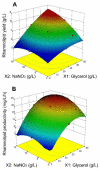Production and Characterization of Rhamnolipids Produced by Pseudomonas aeruginosa DBM 3774: Response Surface Methodology Approach
- PMID: 35888990
- PMCID: PMC9321515
- DOI: 10.3390/microorganisms10071272
Production and Characterization of Rhamnolipids Produced by Pseudomonas aeruginosa DBM 3774: Response Surface Methodology Approach
Abstract
Rhamnolipids are extensively studied biosurfactants due to their potential in many industrial applications, eco-friendly production and properties. However, their availability for broader application is severely limited by their production costs, therefore the optimization of efficacy of their cultivation gains significance as well as the information regarding the physio-chemical properties of rhamnolipids resulting from various cultivation strategies. In this work, the bioprocess design focused on optimization of the rhamnolipid yield of Pseudomonas aeruginosa DBM 3774 utilizing the response surface methodology (RSM). Six carbon sources were investigated for their effect on the rhamnolipid production. The RSM prediction improved the total rhamnolipid yield from 2.2 to 13.5 g/L and the rhamnolipid productivity from 11.6 to 45.3 mg/L/h. A significant effect of the carbon source type, concentration and the C/N ratio on the composition of the rhamnolipid congeners has been demonstrated for cultivation of P. aeruginosa DBM 3774 in batch cultivation. Especially, changes in presence of saturated fatty acid in the rhamnolipid congeners, ranging from 18.8% of unsaturated fatty acids (carbon source glycerol; 40 g/L) to 0% (sodium citrate 20 g/L) were observed. This demonstrates possibilities of model based systems as basis in cultivation of industrially important compounds like biosurfactants rhamnolipids and the importance of detailed study of interconnection between cultivation conditions and rhamnolipid mixture composition and properties.
Keywords: Pseudomonas aeruginosa; biosurfactants; fractional factorial design.
Conflict of interest statement
The authors declare no conflict of interest.
Figures



References
-
- Savla N., Pandit S., Khanna N., Mathuriya A.S., Jung S.P. Microbially powered electrochemical systems coupled with membrane-based technology for sustainable desalination and efficient wastewater treatment. J. Korean Soc. Environ. Eng. 2020;42:360–380. doi: 10.4491/KSEE.2020.42.7.360. - DOI
-
- Koo B., Jung S.P. Improvement of air cathode performance in microbial fuel cells by using catalysts made by binding metal-organic framework and activated carbon through ultrasonication and solution precipitation. Chem. Eng. J. 2021;424:130388. doi: 10.1016/j.cej.2021.130388. - DOI
LinkOut - more resources
Full Text Sources

